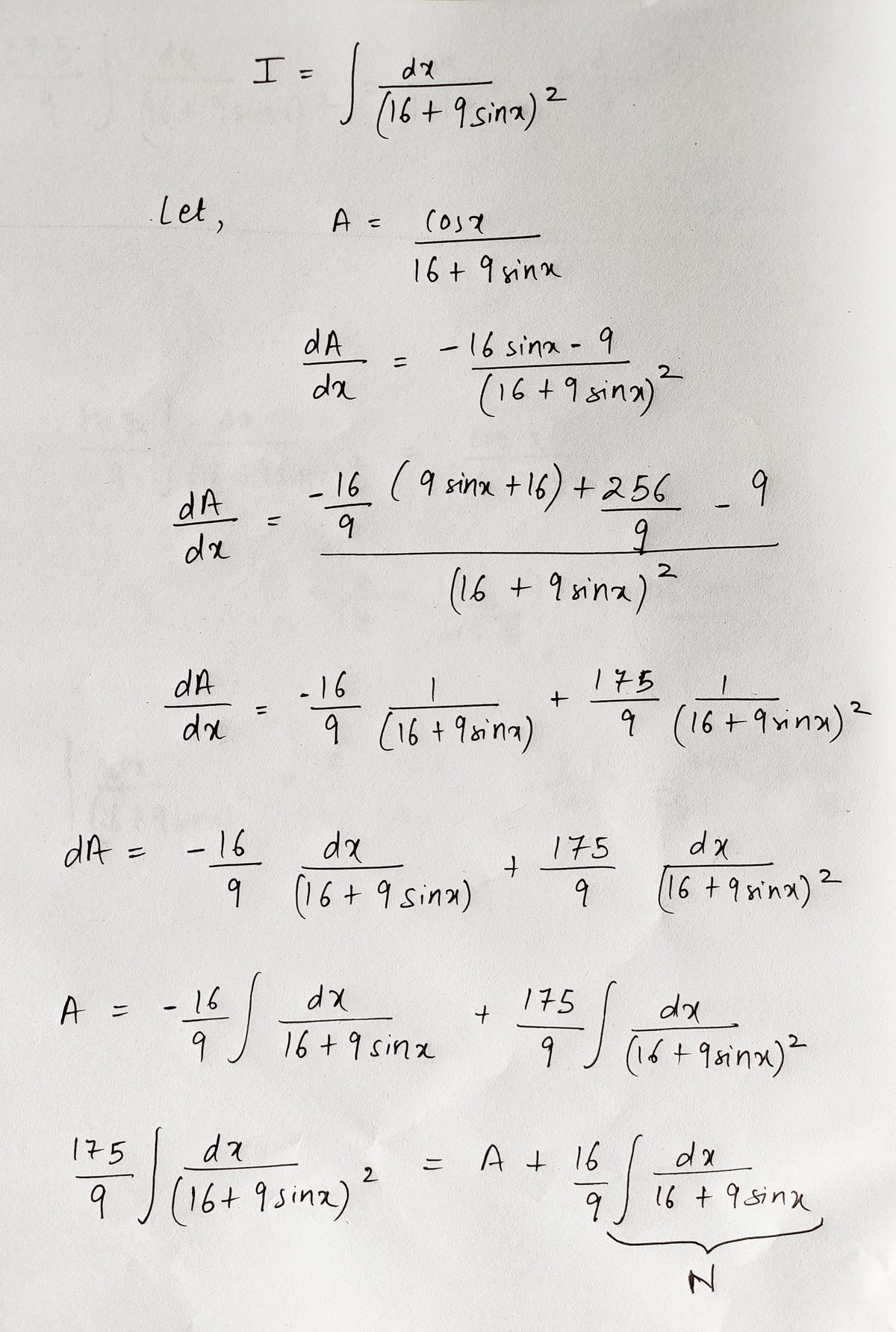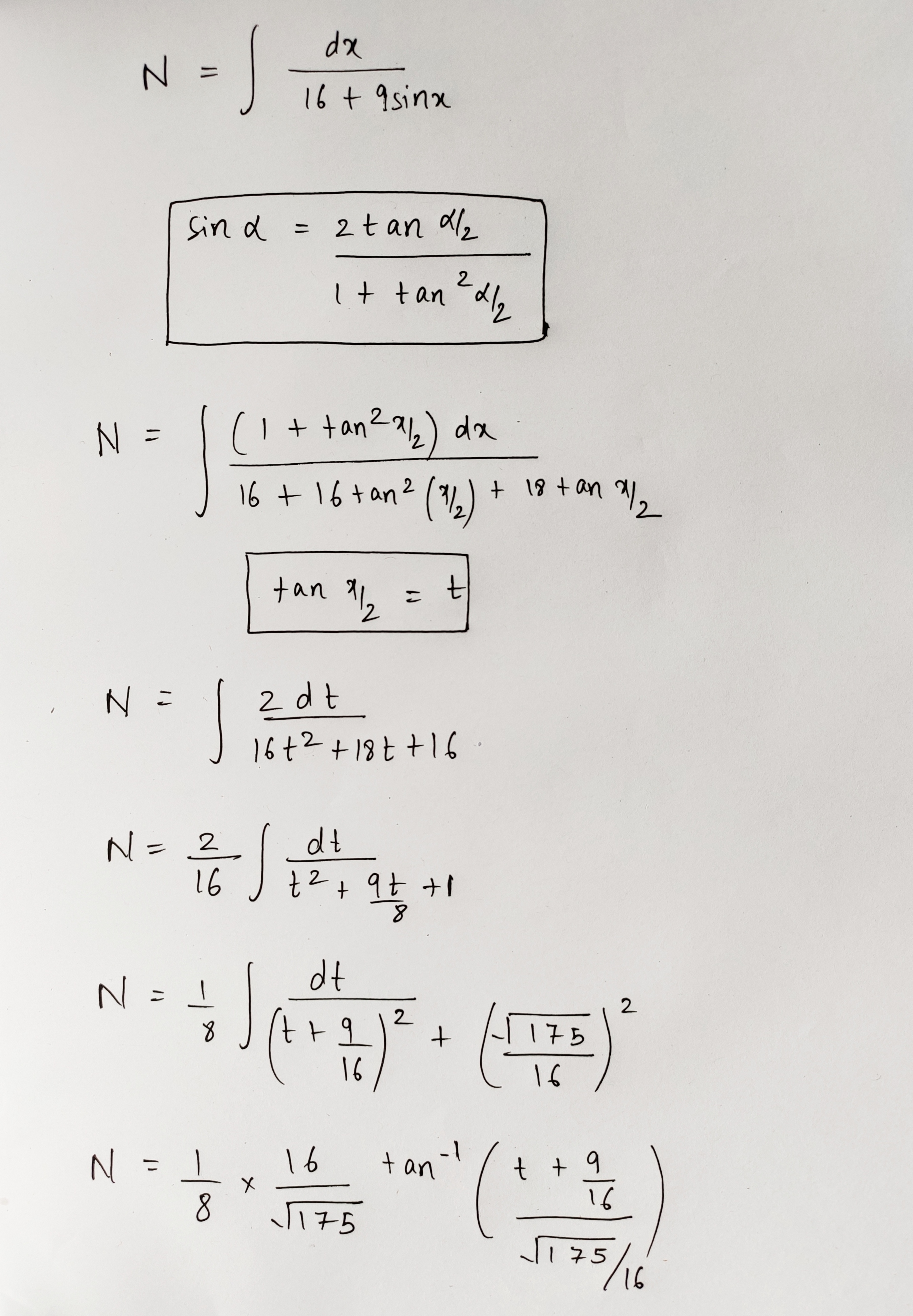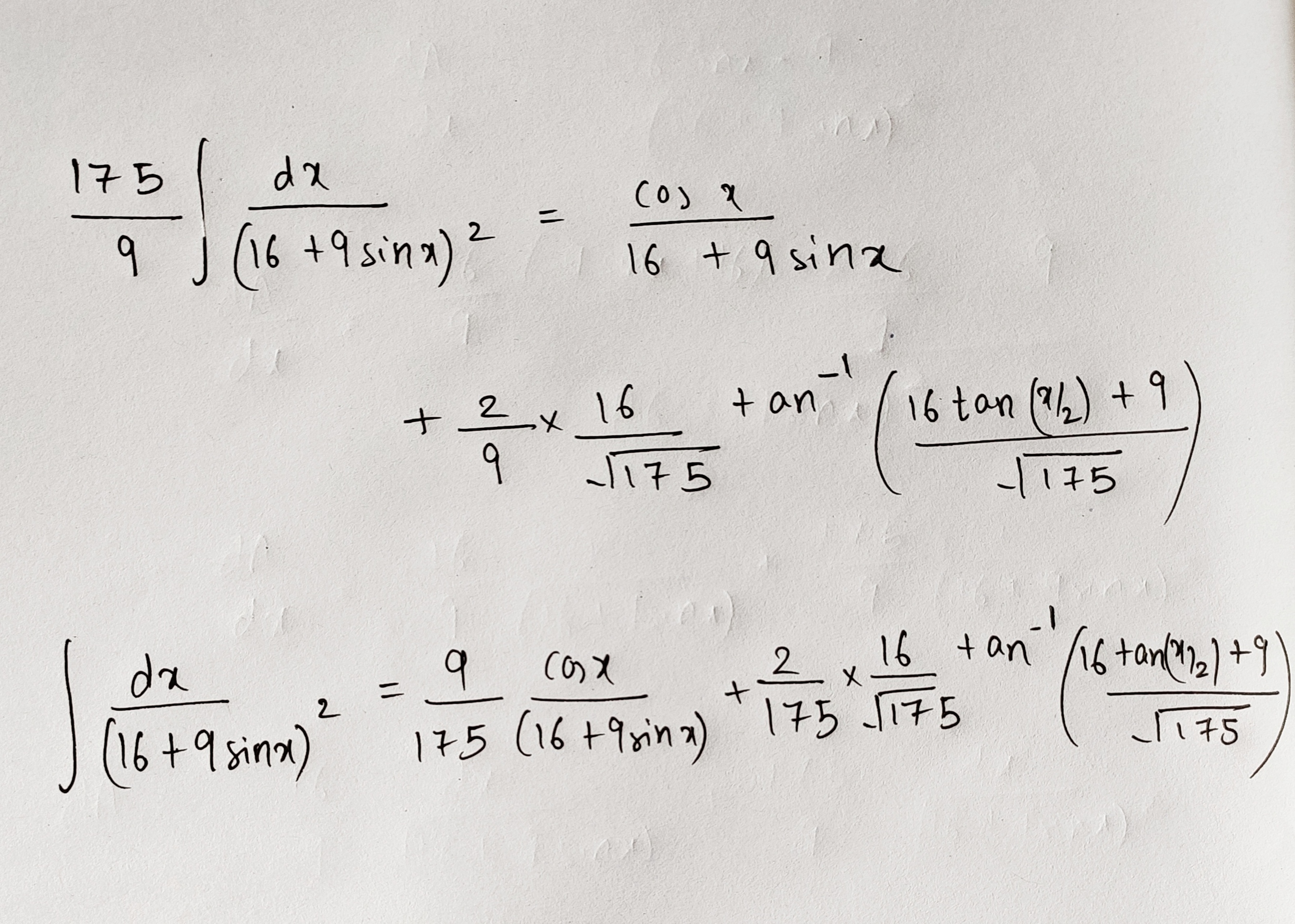Luscious Integration
Here is a problem
Here is the solution



Feel fee to ask anything regarding my solution.
No vote yet
1 vote
Easy Math Editor
This discussion board is a place to discuss our Daily Challenges and the math and science related to those challenges. Explanations are more than just a solution — they should explain the steps and thinking strategies that you used to obtain the solution. Comments should further the discussion of math and science.
When posting on Brilliant:
*italics*or_italics_**bold**or__bold__paragraph 1
paragraph 2
[example link](https://brilliant.org)> This is a quote# I indented these lines # 4 spaces, and now they show # up as a code block. print "hello world"\(...\)or\[...\]to ensure proper formatting.2 \times 32^{34}a_{i-1}\frac{2}{3}\sqrt{2}\sum_{i=1}^3\sin \theta\boxed{123}Comments
Here's an alternative approach.
Let y=2π−x. Then, the integral becomes I=−∫(16+9cosy)2dy.
Using half angle tangent substitution, we have t=tan(2y),cosy=1+t21−t2 and dy=1+t22⋅dt. The integral transforms to
I000000======−2∫(16+9(1+t21−t2))21⋅1+t21dt−2∫(16(1+t2)+9(1−t2))21+t2dt−2∫(7t2+25)2t2+1dt−72∫(7t2+25)27t2+7dt−72∫(7t2+25)27t2+25−18dt−72∫7t2+251dt+736∫(7t2+25)21dt
For both integrals, apply the trigonometric substitution, 7t=5tanu⇒7=5sec2u⋅dtdu.
I0000====−72∫25sec2u1⋅75sec2udu+736∫(25sec2u)21⋅75sec2udu−3572∫du+875736∫cos2udu−3572u+875736⋅41(sin(2u)+2u)+C−875732u+87579sin(2u)+C
What's left is to back-substitute. u=tan−1(57t)=tan−1(57tan(2y))=tan−1(57tan(2π/2−x)). Finishing it off with tan(2π/2−x)=1+tan(2x)1−tan(2x), we get:
I=−875732tan−1(57tan(1+tan(2x)1−tan(2x)))+87579sin[2(tan−1(57tan(1+tan(2x)1−tan(2x))))]+C
Log in to reply
@Pi Han Goh very very nice. Thanks for sharing.
By the way, do you know I am Neeraj . Due to some reason I have changed my name
Log in to reply
Now I know.
Log in to reply
@Pi Han Goh your integration skills are very nice.
@Pi Han Goh
Nice one. I like it.
@Pi Han Goh Btw have you ever participated in an Integration bee or an Integration competition? Holy shit... you're really good!
Log in to reply
No, but I'm aware of these competitions.
Log in to reply
@Pi Han Goh how to solve this integration, is there any alternative methods also? , ∫π2πx3(x2+2)cosxdx
Thanks in advance
Log in to reply
Try posting each distinct question in a different note. Otherwise, it gets really cluttered and messy to see what note is.
Log in to reply
@Pi Han Goh ok, I will post a note after one hour.
@Pi Han Goh I have upvoted your solution here also, see above.
@Krishna Karthik Here it is, I'm going to bed now.
@Steven Chase @Karan Chatrath , in case you guys are interested.
Log in to reply
Yeah; it's really impressive. Good job mate :)
Here's another method:
The integrand can be expressed as (16+9sinx)21+9cosx−9cosx=(16+9sinx)21+9cosx−(16+9sinx)29sinx.
Split this into two integrals, for the first integral, let y=2π−x then t=tan(2y), and you can solve it like how I've written in my other comment. And use u=16+9sinx to solve the second integral.
Log in to reply
@Pi Han Goh Thank you so much
Bruh that's fuggin awesome!!!!
Log in to reply
@Krishna Karthik Do you know above line?
Log in to reply
Sorry? Yeah; you're going to bed. Cya.
Log in to reply
@Krishna Karthik it is the style of Steven Sir.
Log in to reply
Lol I just love how you added a funny little "plus C" at the end lmao
Log in to reply
@Krishna Karthik i forgot to write it in page. But this seems me more beautiful.
Conclusion:Everything happens for good
@Pi Han Goh @Krishna Karthik can you please help me in this integration ∫π2πx3(x2+2)cosxdx
Log in to reply
@Lil Doug This one's actually quite easy. I'll post a solution soon.
Log in to reply
@Krishna Karthik please post it now.
Log in to reply
So, the integral can be rewritten as:
∫(xcos(x)+x32cos(x))dx
So, we can split it into two integrals, which we can do using integration by parts.
∫xcos(x)dx+2∫x3cos(x)dx
So, we do integration by parts with the first half:
u=x1, dv=cos(x)
du=−x21, v=sin(x)
So, it can be rewritten as:
I1=xsin(x)−∫x2sin(x)
Doing integration by parts for the second half, we get:
I2=−2x2cos(x)−∫x2sin(x)
Now simplifying, ∫x2sin(x) cancels out, leaving:
x2xsin(x)−cos(x)+C
So substituting, you get:
4π2−5
Log in to reply
@Krishna Karthik how does it get cancel, both are negative, both will add up.
Log in to reply
Oh wait... shit. I fucked up. So, let's try to calculate that integral ∫x2sin(x)
@Krishna Karthik what answer you are getting?
Log in to reply
I've posted the solution. It's just integration by parts.
I suspect the indefinite integral is in the form of A⋅xsinx+B⋅x2sinx+C⋅xcosx+D⋅x2cosx, where A,B,C,D are constants. Differentiating this expression with respect to x should gives us back the integrand x3(x2+2)cosx.
Using quotient rule and comparing coefficients, we will get (A,B,C,D)=(1,0,0,−1), thus ∫π2πx3(x2+2)cosxdx=[xsinx−x2cosx]π2π=−4π25≈−0.126651.
@Krishna Karthik i am getting I1=xsinx+∫x2sinxdx
Log in to reply
You missed out the −x2cos(x) term.
Log in to reply
@Krishna Karthik where bro, I am. Telling I1
Log in to reply
Oh oops; my bad. Yup. I meant the exact same thing as you. So they should cancel!
Wait... how are you getting a positive ∫x2sin(x)? It should be negative because −x21
Btw, numerically integrating, I'm getting -0.12779
Log in to reply
@Krishna Karthik share the code also.
Log in to reply
I'm just using a standard midpoint rule calculator through python.
Log in to reply
@Krishna Karthik share the code means share the code.
Log in to reply
Lmao, ok. Coming up.
@Lil Doug The code.
Log in to reply
Btw, you can shorten your code by doing this instead:
Log in to reply
@Pi Han Goh I don't like to code in single-line style. I prefer readability as a programmer, personally.
Usually, I prefer to indent functions so I can see what is inside the function clearer. And btw thx for the suggestion of using it as just cos and pi rather than specifying the library.
Log in to reply
@Krishna Karthik No matter whatever you like, First upvote his alternative method of this note integration above.
Log in to reply
@Lil Doug Oh yeah; sorry I forgot to. You can't upvote subcomments, though, sadly.
@Krishna Karthik They are not cancelling bro
I think you have copied the solution and just paste it here.
Not taken a look on the solution
Log in to reply
No, I looked. And you're right; they're not cancelling. My integration by parts has failed. We should work out ∫x2sin(x)
Log in to reply
@Krishna Karthik it is not your integration by parts .
It is the mistake of this website https://www.integral-calculator.com/ who told you wrong method
Log in to reply
Integral calculator? I worked most of this out by hand; I tried integrating by parts. I checked with integral calculator because I got stuck midway; it mistakingly said it would cancel out (integral calculator can be stupid sometimes...) so I copied an integration by parts method from them. Maybe there's some weird trig substitution or something that I'm missing. I'll try the problem soon.
Log in to reply
@Krishna Karthik. you code is also not working
Log in to reply
It is. Show me your screen so I can debug for you.
Btw the my midpoint rule calculator seems to be coming up with a reasonable answer. This is actually a tricky problem... maybe integration by parts isn't the trick. Ask Pi Han Goh.
@Lil Doug I just posted a new note; it's a photo of the working code.
@Pi Han Goh here above you can see
Log in to reply
A few pointers:
Why start with A=⋯ (yes, I know the answer to this question). But you seem to pull it out of thin air without any justification.
Say you used quotient rule, otherwise, the newbies can't follow this reasoning.
At least motivate why you want to work on the differentiation of A first, by first explaining that the original integrand needs to be broken down (by considering a lesser power in the denominator).
Where did your sinα=⋯ come from ? (I know the answer to this question too) It seems mystifying to the uninitiated.
At least make it explicit why you want convert the integrand in the form of t2+a21 in the final step.
Handwriting issue: Some of your brackets does not properly encapsulate the required expressions.
Handwriting issue: Some of your fractions' horizontal line should be longer.